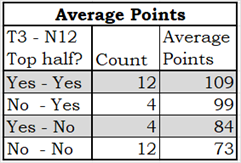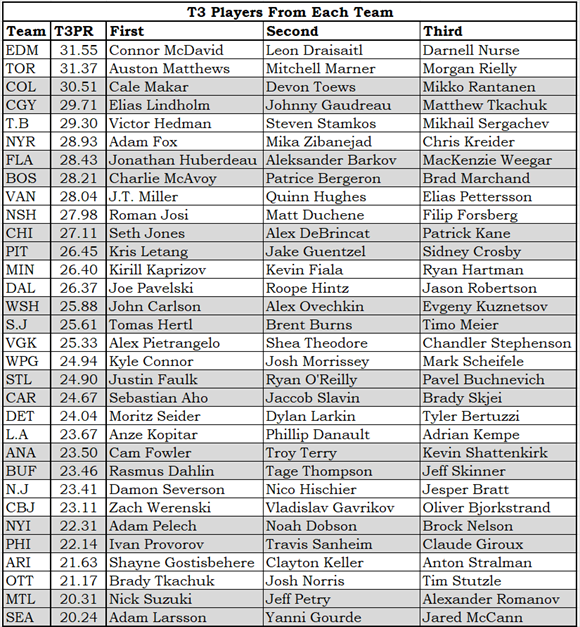When it comes to team success, is it more important to have three very good players or to have a very good team core? And by team core, I mean the 12 next-best players on the team.
This question is perfectly suited to investigate using Productivity Rating (PR). PR will show which players were in the top three on their team in a season, and which are in the next twelve. With this data, we can rank the teams by their strength in the two categories and see how their strengths translated to regular season success.
Handling Players Who Were Traded Mid-Season
Players who were traded mid-season have one PR-Score for the season but they played on two or more teams during the season. Daniel Sprong will serve as the example of how these players are handled. Sprong had a season PR-Score of 3.1112 (PR-Fringe), playing 15 games for Seattle and 47 for Washington. Sprong’s PR-Score was apportioned to those two teams based on how many games he played for them. The Sprong who played is Seattle got a PR-Score of 0.7527, while the Washington Sprong got a PR-Score of 2.3585.
Sprong ranked 21st in Seattle and 19th in Washington. He didn’t make the top fifteen for either team.
Study Details
Only 2021/2022 regular season data was used. Traded players had their PR-Score apportioned to the teams they played for (see above) and then the data was sorted by team and PR-Score to identify each team’s top three (T3) and next twelve (N12) players.
As regular season data was used, the focus of this study will focus on regular season results. But the Stanley Cup Finals are underway as this article is being written, and it’s impossible not to peek at how the playoff teams did.
I’ll first rank the teams in terms of their T3 players, next in terms of their N12 players. While the individual team scpres have no contextual information (is an N12 total of 61.48 good or bad or meh?), you’ll be able to see the sums of all 32 teams in one place which will quickly give you all the context you need.
If you are a fan of les Habs, brace yourself. Looking at the total score of their best fifteen players (T3 + N12), Montreal is a tidy 31st, slightly ahead of a team that is playing the next several years in a stadium that many Canadian Junior teams would be ashamed to use.
Team Rankings – Top 3 (T3)

Edmonton, Toronto and Colorado have truly impressive T3 talent: the average PR-Score of their players would be in the PR-Elite category (PR-Score of 10 or more). Boston’s top three players are all PR-Star players. A complete list of the T3 players for each team is in an Appendix in this document.
Matthew Tkachuk was the third best player for Calgary last season. His PR-Score would have put him in first on nineteen other teams.
Clearly, you can’t win with just T3 talent: Vancouver and Chicago were 9th and 11th in T3 talent, but 19th and 28th in N12 talent, and that lack of depth dragged them down the standings.
It looks like regular season success is linked to T3 talent. Thirteen of the top sixteen T3 teams made the playoffs. Can N12 be more meaningful for a team? Let’s find out.
Team Rankings – Next 12 (N12)

Subjectively, the N12 rankings seem right. All of the top N12 teams have ridiculously deep talent.
Fourteen of the top sixteen N12 teams made the playoffs. That’s one small indication that N12 talent is more important than T3 talent.
Another piece of evidence comes from what happens if a team is in the top sixteen of only one of T3 and N12. As you would expect, the teams that were in the top sixteen of both T3 and N12 did very well in the standings, and those that were in the bottom sixteen for both did quite poorly. It’s the middle two data lines of the next table that are telling.

Four teams were in the top half of N12 only, and they averaged 99 points. Four teams were in the top half of T3 only, averaging 84 points. While this is a small number of data points in just one season, it is an indication that team depth is more important in the regular season.
Summary
The original question asked whether a team was better off with strong top-three talent or strong next-twelve talent. The best answer, it turns out, is “yes”. A team is most likely to succeed in the regular season if it has strong T3 and strong N12 talent.
Neither T3 nor N12 talent can propel a team to success by itself, but in this last regular season, N12 talent was slightly more important to success than was T3 talent.
In the playoffs, the story may be different. The four semi-finalists were in the top six in the league for T3 talent (1st, 3rd, 5th, 6th), but they were 5th, 7th, 12th and 16th in N12 talent.
I said “the story may be different” because this could have been a fluke season. Sometime in the future, I’ll do this study for all seasons since 2007. There will be fifteen times more data, so the results will be more reliable. Who knows, maybe the team’s top five players (3 forwards, 2 defensemen) are the most important group.
Ottawa’s Top 3 was 30th Best?
Ottawa fans may not agree with their team’s placement on the T3 list in particular: 30th out of 32 seems a bit low. I should point out that I am an Ottawa fan I was a little surprised by seeing the Senators place that low on the list.
I’m not going to change either the PR-Score formula or the method for T3 just because I don’t like one specific result: to quote Niels Bohr, the founder of the bizarre science of quantum mechanics, that ain’t the way science works. (Not an actual quote.)
I wondered if there were any other sites which had player ratings for the 2021 season. I found two. What do they think of the Senators?
The first site didn’t provide a rating for Artem Zub, Josh Norris or Tim Stutzle. Other Senator regulars were also unrated. The site opined that Andrew Agozzino, who played one game, was a better player than Nikita Zaitsev, Tyler Ennis and Chris Tierney. I must have missed that game. Given it had no rating for significant players and the ratings it had were obviously unreliable, I didn’t care who it thought Ottawa’s top three players were.
The other site had Ottawa’s top three as Chabot, Tkachuk and a tie at third between Connor Brown and Josh Norris: Agozzino was nowhere in site. Its results seemed reasonable, but it must have a “per game” approach or maybe a future-looking aspect: it’s the only way Chabot and Connor Brown could be ranked highly, given they both missed many games in 2021.
Stapled To The Bench has two player-rating systems, Value Rating (VR) and Productivity Rating (PR). Chabot has a higher VR than Tkachuk, but Tkachuk had a better 2021 PR than Chabot. When you are looking for which players had the better season, only PR-Score matters. I like the PR results better than the second site’s results. Connor Brown is 7th in PR for Ottawa, with 4th through 6th being Artem Zub, Thomas Chabot and Nick Holden.
It would be impossible to argue that Ottawa’s top three players had better seasons then the top three players on most of the other teams. It’s the sort of argument a sportswriter would make: you have to rely on emotion and ignore the logic.
The future for Ottawa is bright, because its top three players (along with several others) are young and likely to improve in the coming years. When they finally make the playoffs (in the 2024 or 2025 season), their T3 and N12 ranking will be much better.
T3 Players From Each Team
The list below shows the top three players from each team, showing their total PR-Score.

Claude Giroux is the only player on this list that was traded mid-season. It has been a long time since a player of his caliber was traded mid-season.
